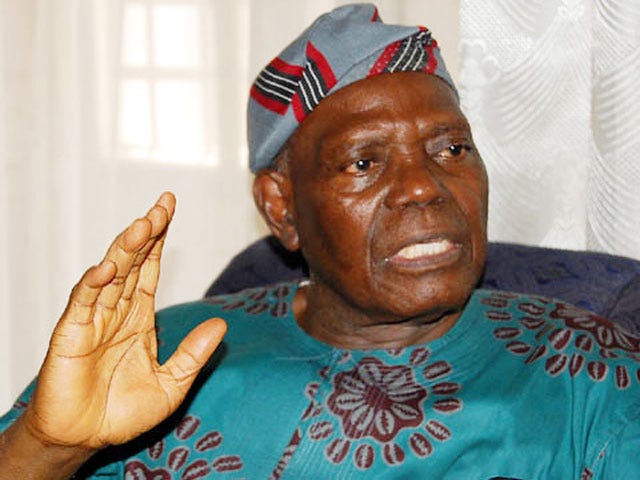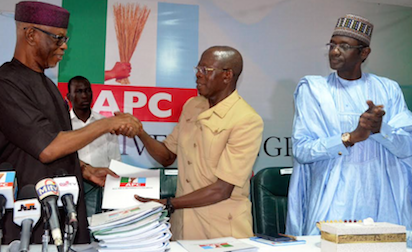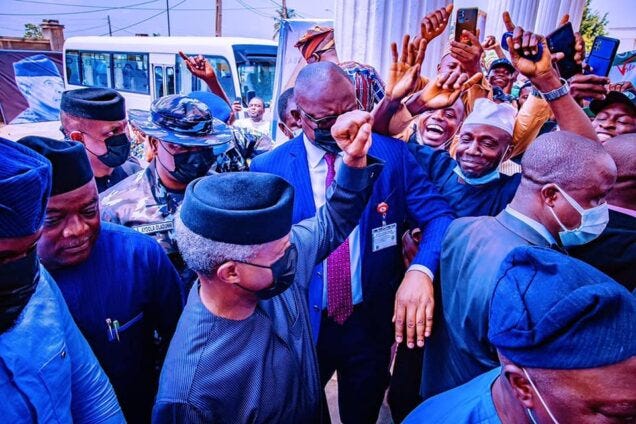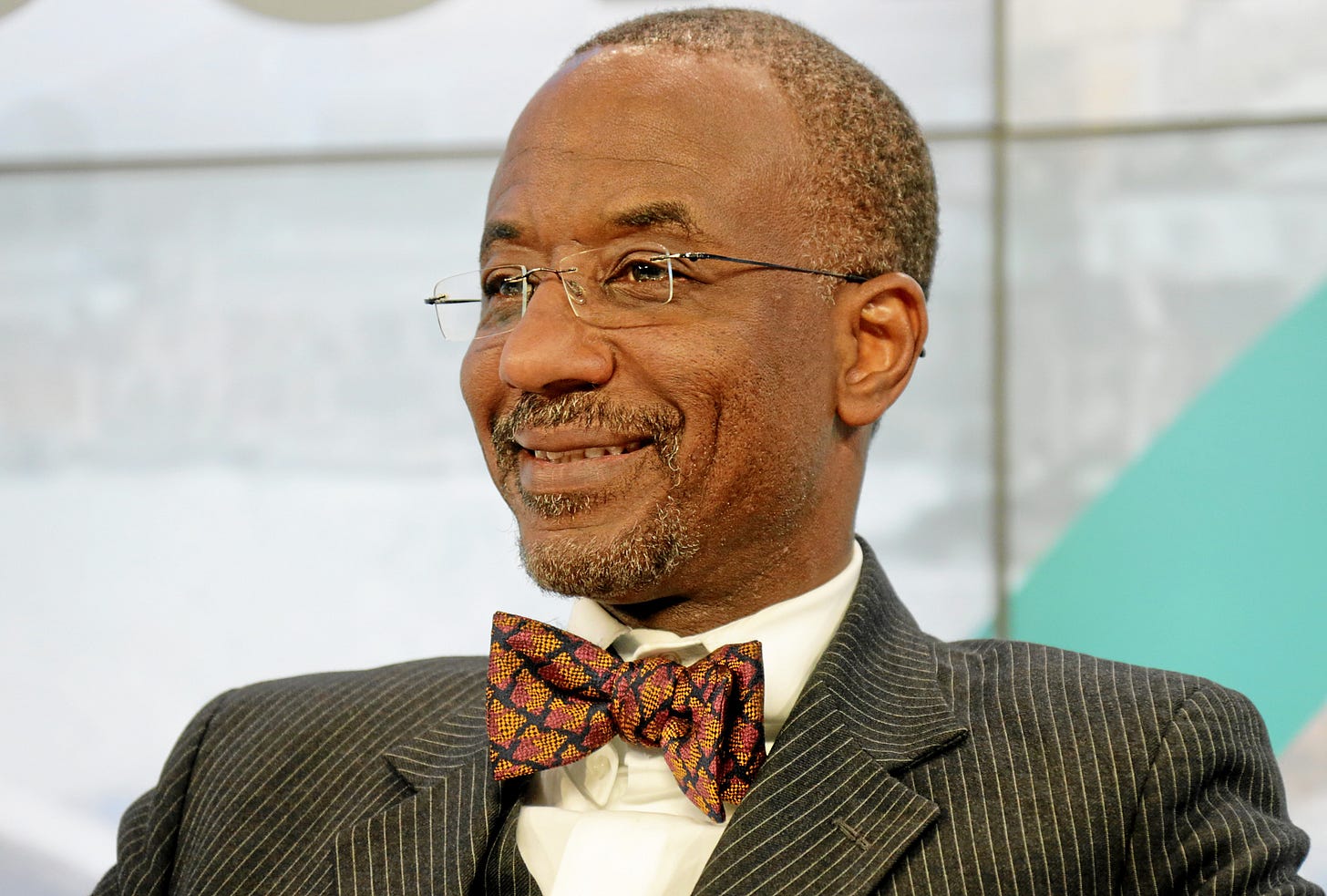
By April 2013 the oil theft situation had worsened. Moreover, multiple reports on Nigerian television channels, on the internet and in international and domestic print media continued to quote NOI regarding the severity of the problem.
While such media coverage had been constant from June 2012 up to this point, a new political party announced its launch in February 2013. The All Progressive’s Congress, better known nowadays as the APC.
The APC was formed as an amalgamation of Nigeria’s largest opposition parties: the Action Congress of Nigeria (ACN), the Congress for Progressive Change (CPC), the All Nigeria Peoples Party (ANPP), part of the All Progressives Grand Alliance (APGA) and the defection of a faction of the People’s Democratic Party (PDP) — self-styled ‘the New PDP.’
Now a certain Yemi Osinbajo, relative of Tory opposition party leader Kemi Badenoch, was recruited by his Lagos State boss and CAN leader, Bola Tinubu, to craft the APC’s manifesto.
Much of the manifesto had what you would expect from your average political party — in the case of the APC, scores of unattainable promises[i]. However, they reprised ACN trigger terms that prolifically featured throughout Nigerian media from 2012 up to the party’s formation: “Boko Haram,” “insecurity in the north,” and “eliminating endemic corruption.”
Good work Osinbajo and Co.
Anyway.
It was 10 pm one early October evening in 2013 and NOI was routinely wrapping up her working day. It should have been an uneventful evening like any other.
Except it wasn’t.
The first development was a phone call from EMT colleague, the Central Bank Governor, Sanusi Lamido. Given the pair had a cordial working relationship, speaking as often as twice a day, the call was not unusual by any means. They were respectful of each other’s views — even where they didn’t agree — and shared concerns about the unaccounted-for oil revenue and its destabilizing impact on the country’s foreign exchange reserves.
This particular call came with devastating news. He informed NOI of a letter he had sent to the president on September 25th, 2013, drawing his attention to an unaccounted-for sum of $49.8 billion in the period from January 2012 to July 2013.
This figure was alarming — the size of it was reportedly what made him inform the president given the potential economic impact it could have on the country.
NOI didn’t dispute the ongoing issue of missing sums, but $49.8 billion was over 50 percent of the total oil revenue for that period. Surely this could only happen in a “banana republic,”[ii] she reasoned.
Surely something wasn’t right here.
One thing was for sure. Lamido was aware of the FAAC accounts and their spreadsheet which stated that there was a shortfall of $10 to $12 billion — seemingly a more realistic figure. This was also what she relayed to the president when he sought her opinion the following morning.
Another concern in light of his disclosure was why he bypassed her to go straight to the president. After all, the Central Bank Governor is the banker to the Finance Ministry. In any case, to attempt a resolution, the president suggested NOI set up a meeting with the Central Bank, the Ministry of Petroleum Resources and Finance Ministry, thereby reconciling all irregularities.
This resulted in yet another taskforce being put together to identify any unaccounted-for funds which should have been deposited in the Federation Account. It involved all three agencies and was led by the Director General of the Budget Office, Dr. Bright Okogu, a petroleum economist and experienced macroeconomist who had previous stints at both the Organization of Petroleum Exporting Countries (OPEC) and the International Monetary Fund (IMF).
Unsurprisingly the emergence of the taskforce caused tension and antagonism between officials from the NNPC / Ministry of Petroleum Resources and those from the Central Bank with the Finance Ministry the effective ‘piggy in the middle.’
Much to her horror, NOI was called in the afternoon of December 11th, 2013, by William Wallis, the Africa correspondent of the Financial Times [of London] informing he had a copy of Sanusi’s letter addressed to the president regarding the missing $50 billion. He sought her views, and she told him she believed the sum was too large; that the taskforce would ascertain the real figure and disclose it the following week.
Unfortunately, it was too late.
The following day the missing $50 billion made headlines news in the Financial Times, in addition to domestic and international media — the first time in Nigerian history such substantial revenues had been reported missing.
The taskforce did indeed report back a week later — stating that the numbers had been reconciled and unanimously accepted across all the agencies involved. Governor Lamido’s letter alleged $65 billion worth of crude oil had been produced and sold between January 2012 and July 2013, of which only $15.2 billion had been remitted — leaving $49.8 billion unaccounted for.
However, it emerged that Central Bank colleagues came up with the figure without considering the transfers / arrangements of the oil account. For instance, $15 billion had been remitted directly to the Federal Inland Revenue Service as tax revenues and was then forwarded to the Federation Account. NNPC also lifted $28 billion in crude which was exchanged for refined products. Then there were also obligations payable to joint-venture partners.
When all was said and done, the unaccounted figure unanimously agreed was within the Finance Ministry’s estimated range — between $10.8 billion and $12 billion.
Lamido accepted the errors but the news of the erroneous $50 billion had spread like wildfire. Needing to issue clarity publicly, he accepted NOI’s request to participate in a joint press conference with her and the Minister of Petroleum Resources.
Believing that the matter had been resolved, and a joint effort could be undertaken to recover the missing $12 billion, another blow was dealt.
The day after the press conference, the NNPC issued a paid television ad absolving itself from the erroneous claims of the missing funds alleged by the Central Bank Governor. She contacted the GMD of the NNPC, Andrew Yakubu to request the ad be taken down to limit any humiliation that would blowback on the Governor. Despite Lamido’s complaints and NOI’s efforts, the ad ran for another day.
And there was more drama to come.
Following the taskforce’s submission of their report in December 2013, they were summoned to appear before a Senate ad-hoc Committee, on February 4th, 2014, chaired by the former Governor of Kaduna State and then-Chairman of the Senate Finance Committee, Ahmed Markafi.
First to speak was the Minister of Petroleum Resources. He re-affirmed the figures that had been agreed.
Then came the surprise.
Governor Lamido spoke next and claimed that the missing figure was not $50 billion, neither was it $12 billion but closer to $20 billion — which he supported with exhibits. This included the claim of a $6 billion non-disbursement to the Federation Account by an NNPC subsidiary, the Nigerian Petroleum Development Corporation (NPDC).
More crucially, by disclosing this he had taken NOI completely by surprise. It was her first time hearing this.
Given the bombshell disclosure, the reporters present could not wait to exit the room, armed with juicy content to publicize at the earliest opportunity.
NOI, the last to speak, toed the same line as the Minister of Petroleum Resources — reasserting that the missing figure was about $12 billion. Ultimately, she suggested that the only way the matter could be laid to rest is for an independent forensic audit to be conducted. The Senate agreed, initially, stating that they would manage the audit, however, it later said that the executive branch of government should commission it alternatively.
In the days thereafter the NNPC submitted a report that accounted for $20 billion, yet this was not accepted as credible by the public. Nonetheless, it spread like wildfire, more so than the initial reported figure of $50 billion.
The optics were bad given that the President had suspended Governor Lamido for “financial recklessness”— a decision widely interpreted as punitive and a tacit admission that the $20 billion figure was indeed credible.
The saga seemed to bear parallels with the sum of $3.5 billion[iii] ($1 billion extra than widely reported in the media) that went missing under Buhari in 1978, during his days as Minister of Petroleum Resources when General Olusegun Obasanjo was head of state. It was also redolent of the $12 billion that vanished under the NNPC during General Ibrahim Babangida’s administration.
One minute it was $50 billion, the next $12 billion, then $20 billion!
Which was it?!
[i] “APC LAUNCHES ITS MANIFESTO,” All Progressives Congress, Aug 21, 2013. Url: https://www.allprogressivescongress.org/2013/08/apc-launches-its-manifesto/
[ii] Okonjo-Iweala, FIGHTING CORRUPTION IS DANGEROUS: The Story Behind the Headlines, (The MIT Press: Cambridge|London, 2018), pp.44
[iii] Ibid, pp.49







